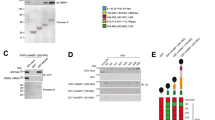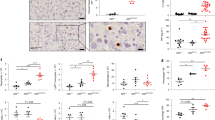Abstract
Deregulated nuclear factor κB (NF-κB) activation plays an important role in inflammation and tumorigenesis. ABIN proteins have been characterized as negative regulators of NF-κB signaling. However, their mechanism of NF-κB inhibition remained unclear. With the help of a yeast two-hybrid screen, we identified ABIN proteins as novel ubiquitin-interacting proteins. The minimal ubiquitin-binding domain (UBD) corresponds to the ABIN homology domain 2 (AHD2) and is highly conserved in ABIN-1, ABIN-2 and ABIN-3. Moreover, this region is also present in NF-κB essential modulator/IκB kinase γ (NEMO/IKKγ) and the NEMO-like protein optineurin, and is therefore termed UBD in ABIN proteins and NEMO (UBAN). Nuclear magnetic resonance studies of the UBAN domain identify it as a novel type of UBD, with the binding surface on ubiquitin being significantly different from the binding surface of other UBDs. ABIN-1 specifically binds ubiquitinated NEMO via a bipartite interaction involving its UBAN and NEMO-binding domain. Mutations in the UBAN domain led to a loss of ubiquitin binding and impaired the NF-κB inhibitory potential of ABINs. Taken together, these data illustrate an important role for ubiquitin binding in the negative regulation of NF-κB signaling by ABINs and identify UBAN as a novel UBD.
This is a preview of subscription content, access via your institution
Access options
Subscribe to this journal
Receive 50 print issues and online access
$259.00 per year
only $5.18 per issue
Buy this article
- Purchase on Springer Link
- Instant access to full article PDF
Prices may be subject to local taxes which are calculated during checkout




Similar content being viewed by others
References
Agou F, Courtois G, Chiaravalli J, Baleux F, Coic YM, Traincard F et al. (2004). Inhibition of NF-κB activation by peptides targeting NF-κB essential modulator (nemo) oligomerization. J Biol Chem 279: 54248–54257.
Calzado MA, Bacher S, Schmitz L . (2007). NF-κB inhibitors for the treatment of inflammatory diseases and cancer. Curr Med Chem 14: 367–376.
Ea CK, Deng L, Xia ZP, Pineda G, Chen ZJ . (2006). Activation of IKK by TNFα requires site-specific ubiquitination of RIP1 and polyubiquitin binding by NEMO. Mol Cell 22: 245–257.
El Bakkouri K, Wullaert A, Haegman M, Heyninck K, Beyaert R . (2005). Adenoviral gene transfer of the NF-κB inhibitory protein ABIN-1 decreases allergic airway inflammation in a murine asthma model. J Biol Chem 280: 17938–17944.
Heyninck K, De Valck D, Vanden Berghe W, Van Criekinge W, Contreras R, Fiers W et al. (1999). The zinc finger protein A20 inhibits TNF-induced NF-κB-dependent gene expression by interfering with an RIP- or TRAF2-mediated transactivation signal and directly binds to a novel NF-κB-inhibiting protein ABIN. J Cell Biol 145: 1471–1482.
Heyninck K, Kreike MM, Beyaert R . (2003). Structure–function analysis of the A20-binding inhibitor of NF-κB activation, ABIN-1. FEBS Lett 536: 135–140.
Hicke L, Schubert HL, Hill CP . (2005). Ubiquitin-binding domains. Nat Rev Mol Cell Biol 6: 610–621.
Liu WK, Yen PF, Chien CY, Fann MJ, Su JY, Chou CK . (2004). The inhibitor ABIN-2 disrupts the interaction of receptor-interacting protein with the kinase subunit IKKγ to block activation of the transcription factor NF-κB and potentiate apoptosis. Biochem J 378: 867–876.
Mauro C, Pacifico F, Lavorgna A, Mellone S, Iannetti A, Acquaviva R et al. (2006). ABIN-1 binds to NEMO/IKKγ and co-operates with A20 in inhibiting NF-κB. J Biol Chem 281: 18482–18488.
Shambharkar PB, Blonska M, Pappu BP, Li H, You Y, Sakurai H et al. (2007). Phosphorylation and ubiquitination of the IκB kinase complex by two distinct signaling pathways. EMBO J 26: 1794–1805.
Shembade N, Harhaj NS, Liebl DJ, Harhaj EW . (2007). Essential role for TAX1BP1 in the termination of TNF-α-, IL-1- and LPS-mediated NF-κB and JNK signaling. EMBO J 26: 3910–3922.
Tang ED, Wang CY, Xiong Y, Guan KL . (2003). A role for NF-κB essential modifier/IκB kinase-γ (NEMO/IKKγ) ubiquitination in the activation of the IκB kinase complex by tumor necrosis factor-α. J Biol Chem 278: 37297–37305.
Van Huffel S, Delaei F, Heyninck K, De Valck D, Beyaert R . (2001). Identification of a novel A20-binding inhibitor of nuclear factor-κB activation termed ABIN-2. J Biol Chem 276: 30216–30223.
Weaver BK, Bohn E, Judd BA, Gil MP, Schreiber RD . (2007). ABIN-3: a molecular basis for species divergence in interleukin-10-induced anti-inflammatory actions. Mol Cell Biol 27: 4603–4616.
Wu CJ, Conze DB, Li T, Srinivasula SM, Ashwell JD . (2006). NEMO is a sensor of Lys 63-linked polyubiquitination and functions in NF-κB activation. Nat Cell Biol 8: 398–406.
Wullaert A, Heyninck K, Janssens S, Beyaert R . (2006). Ubiquitin: tool and target for intracellular NF-κB inhibitors. Trends Immunol 27: 533–540.
Wullaert A, Verstrepen L, Van Huffel S, Adib-Conquy M, Cornelis S, Kreike M et al. (2007). LIND/ABIN-3 is a novel lipopolysaccharide-inducible inhibitor of NF-κB activation. J Biol Chem 282: 81–90.
Wullaert A, Wielockx B, Van Huffel S, Bogaert V, De Geest B, Papeleu P et al. (2005). Adenoviral gene transfer of ABIN-1 protects mice from TNF/galactosamine-induced acute liver failure and lethality. Hepatology 42: 381–389.
Zhou H, Du MQ, Dixit VM . (2005). Constitutive NF-κB activation by the t(11;18)(q21;q21) product in MALT lymphoma is linked to deregulated ubiquitin ligase activity. Cancer Cell 7: 425–431.
Zhou H, Wertz I, O'Rourke K, Ultsch M, Seshagiri S, Eby M et al. (2004). Bcl10 activates the NF-κB pathway through ubiquitination of NEMO. Nature 427: 167–171.
Zhu G, Wu CJ, Zhao Y, Ashwell JD . (2007). Optineurin negatively regulates TNFα induced NF-κB activation by competing with NEMO for ubiquitinated RIP. Curr Biol 17: 1438–1443.
Acknowledgements
We thank B Coornaert and K Heyninck for helpful discussions. This work was supported by grants from the ‘Interuniversitaire Attractiepolen’ (IAP6/18), the Fonds voor Wetenschappelijk Onderzoek-Vlaanderen (FWO; Grant 3G010505), and the Geconcerteerde Onderzoeksacties of the Ghent University (GOA; Grant 01G06B6) to RB and from the Deutsche Forschungsgemeinschaft and the German–Israeli Foundation to ID.
Author information
Authors and Affiliations
Corresponding authors
Additional information
Supplementary Information accompanies the paper on the Oncogene website (http://www.nature.com/onc).
Supplementary information
Rights and permissions
About this article
Cite this article
Wagner, S., Carpentier, I., Rogov, V. et al. Ubiquitin binding mediates the NF-κB inhibitory potential of ABIN proteins. Oncogene 27, 3739–3745 (2008). https://doi.org/10.1038/sj.onc.1211042
Received:
Revised:
Accepted:
Published:
Issue Date:
DOI: https://doi.org/10.1038/sj.onc.1211042
Keywords
This article is cited by
-
Mechanisms underlying linear ubiquitination and implications in tumorigenesis and drug discovery
Cell Communication and Signaling (2023)
-
NEMO reshapes the α-Synuclein aggregate interface and acts as an autophagy adapter by co-condensation with p62
Nature Communications (2023)
-
Structural basis for the simultaneous recognition of NEMO and acceptor ubiquitin by the HOIP NZF1 domain
Scientific Reports (2022)
-
Ubiquitin-binding domain in ABIN1 is critical for regulating cell death and inflammation during development
Cell Death & Differentiation (2022)
-
A20 and ABIN-1 cooperate in balancing CBM complex-triggered NF-κB signaling in activated T cells
Cellular and Molecular Life Sciences (2022)



